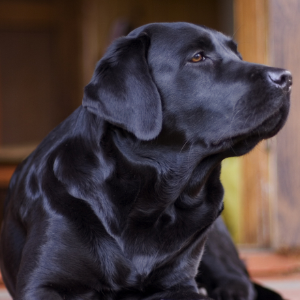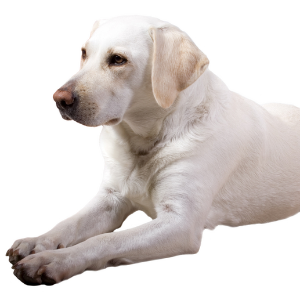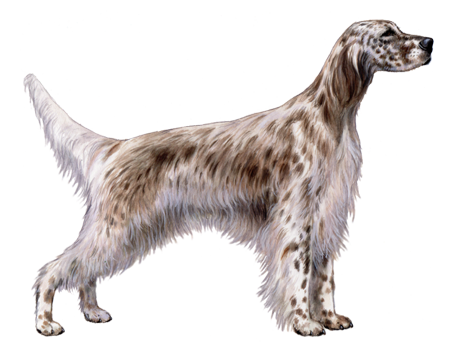
Labrador Retriever
Labrador Retrievers are well-known for their outgoing, family-friendly personalities. Happy to work hard or play hard, these adaptable, good-natured dogs have earned their place as one of the world's most popular breeds.
Interested in discovering if your dog is a Labrador Retriever?
Check out Wisdom Panel's DNA tests.

Labrador Retriever Traits
General Appearance
Labradors are strongly built dogs with short coupling (meaning, the space between their last rib and their pelvis is relatively short). They have broad skulls and are broad and deep through their chest and ribs.
Coat and Coloring
The coat of the Labrador Retriever is short and dense, without any wave or feathering. Labs also possess a weather-resistance undercoat that protects them from water and cold temperatures.
Labrador Retrievers come in solid black, chocolate, or yellow. The yellow varies from a pale cream to a rich red fox color. Some Labradors also have white chest blazes.
Labradors typically have black or brown noses. In some yellow Labs, the nose color may fade to a lighter or dull pink color, known as a Dudley nose, as the dog ages.
Distinctive Physical Traits
Signature to Labrador Retrievers are a weather-resistant coat, drop ears, distinctive tails, and friendly, expressive eyes. Labrador Retrievers also have a unique tail that is very thick at the base and gradually tapers toward the tip. Its rounded appearance is sometimes described as an "otter tail."
Labrador Retriever Temperament
The Labrador Retriever is one of the best breeds for families and can be an excellent breed for even an inexperienced dog owner. Known for their happy-go-lucky, easy-going personalities, these dogs are always up for adventure. They like to be included in all aspects of family life.
Very social dogs, Labrador Retrievers bond easily with people, as well as other dogs and pets. They are patient, affectionate, and trustworthy around children, making them excellent playmates and a welcome addition to most any family.
Though generally calm and good-natured, some Labrador Retrievers can be quite energetic. They are well-suited for an active lifestyle filled with outdoor activities such as hiking and swimming.


Labrador Retriever History
Despite the name, the Labrador Retriever originated not in Labrador, but on the coast of Newfoundland in the 17th century. Thought to be a descendant of the now-extinct "St. John's Water Dog," they were trained to retrieve fishing nets from the icy waters of the North Atlantic. The breed's dense coat and strong swimming abilities made it ideally suited for this job.
These dogs—known at the time as simply the "Lesser Newfoundland"—eventually died out in the area. But before that happened, English fishermen brought the breed to England in the 19th century. There, they were lauded for their swimming, retrieving, and hunting skills. It's believed that the Labrador Retriever got its name from the Earl of Malmesbury. He fell in love with the dogs and coined the name "Labrador" or "Lab" to differentiate them from their Newfoundland ancestors.
English breeders refined the breed during the second half of the 19th century and are responsible for the Labrador Retrievers that we know and love today. A relatively new breed, the Labrador Retriever was recognized by the English Kennel Club in 1903, and the AKC in 1917.
Today, Labrador Retrievers are beloved family dogs that enjoy agility, hunting, tracking, competitive obedience, and swimming. Labs are also commonly used as working dogs—employed as guide dogs, assistance dogs, search and rescue dogs, and contraband detection dogs.
Labrador Retriever Care
Nutrition
Labrador Retrievers need a high-quality, age-appropriate dog food. They will benefit from diets that are formulated for large-breed dogs. In particular, large-breed puppy diets prevent them from growing too fast, which can help protect them from hip dysplasia in adulthood.
Labrador Retrievers have big appetites and, left to their own devices, will actively seek out human food and snacks. For this reason, they are prone to becoming overweight or obese. To keep their weight in a healthy range, their food intake—including treats—should be closely monitored.
Grooming
To maintain a healthy coat, Labrador Retrievers should be brushed weekly (or more often during seasonal shedding periods). They may need occasional baths to keep them clean, particularly after outdoor activities.
Labradors, like all dogs, require regular dental care, including at-home teeth brushing and professional dental cleanings. Maintaining good dental hygiene is important for their overall long-term health.
Exercise
The Labrador Retriever requires a lot of exercise to stay at a healthy weight and burn off extra energy (so they can maintain that calm, laid back demeanor). They enjoy daily walks and opportunities to run or swim.
Because they are retrievers by nature, Labs also love to play fetch and are often happiest when chasing after a ball or frisbee. If a Labrador doesn't get enough exercise, they can be prone to destructive behaviors, such as chewing or digging.
Finally, it's important to give Labrador Retrievers plenty of mental exercise. This can include giving them puzzle toys or practicing obedience commands with them.
Training
Labrador Retrievers are intelligent and eager to please—a combination that makes them a relatively easy breed to train. They are also highly motivated by food, which can be used to your advantage. Simply offer a small treat as a reward for desired behaviors, such as dropping an object or responding to "come," "sit," and other commands.
Labradors have the tendency to pull while on leash. Start practicing appropriate leash skills early and consistently to curb this behavior.

Labrador Retriever Genetic Health Conditions
-
Muscular Dystrophy (Discovered in the Labrador Retriever) Variant 1
Muscular Dystrophy is a severe disorder that causes muscle degeneration and weakness due to the formation of excess connective tissue in the muscle. This variant (UCMD) was discovered in the Labrador Retriever.
-
Alexander Disease
Alexander disease is a rare, fatal neurological disease, causing progressive weakness in all limbs.
-
Exercise-Induced Collapse
Exercise-Induced Collapse (EIC) is a neuromuscular disorder which can cause incoordination and weakness, resulting in collapse, after periods of strenuous exercise.
-
Ehlers-Danlos Syndrome (Discovered in the Labrador Retriever)
Ehlers-Danlos Syndrome (EDS) is an inherited connective tissue disorder characterized by skin that is easily stretched, fragile, and easy to bruise, as well as increased flexibility of joints. The associated genetic variant has been identified in the Labrador Retriever.
-
Obesity risk (POMC)
A number of factors can affect appetite and risk of obesity. This particular test detects a mutation in the POMC gene, known to regulate appetite, that has been associated with increased appetite and obesity in dogs. The associated genetic variant has been identified in the Labrador Retriever and Flat-Coated Retriever. The clinical significance of this variant in dogs of other ancestry is not yet clear.
-
Hemophilia A (Discovered in the Labrador Retriever)
Hemophilia A, also known as Factor VIII Deficiency, is a blood clotting disorder that can cause bruising or abdominal bleeding without apparent reason. The associated genetic variant has been identified in the Labrador Retriever. However, please note that this variant does not explain all occurrences of Hemophilia A in the breed, indicating additional genetic causes remain to be discovered.
-
Hereditary Elliptocytosis
Hereditary Elliptocytosis is a disease where the red blood cells are abnormally oval shape, rather than the characteristic biconcave or dumbbell shape that is normally seen.
-
Hereditary Nasal Parakeratosis (Discovered in the Labrador Retriever)
Hereditary nasal parakeratosis (HNPK) is a disorder causing crusting and dryness of the nose, leading to soreness and irritation.
-
Hyperuricosuria
Hyperuricosuria (HUU) is a condition that predisposes affected dogs to the formation of urinary stones, such as kidney or bladder stones.
-
Congenital Myasthenic Syndrome (Discovered in the Labrador Retriever)
Congenital Myasthenic Syndrome (CMS) is a neuromuscular disorder. Affected dogs suffer from exercise intolerance and collapse after 5-30 minutes of exercise.
-
Congenital Cornification (Discovered in the Labrador Retriever)
Congenital Cornification is a rare X-linked dominant skin disorder. Affected females with one copy of the variant have shown striped, symmetrical thickening of the skin and paw pads, lameness associated with paw pad lesions, and stunted growth. The variant is thought to be lethal in affected males and, possibly, females with two copies. The associated genetic variant has been identified in the Labrador Retriever.
-
Stargardt Disease (Discovered in the Labrador Retriever)
Stargardt Disease (STGD) is a form of late onset retinal degeneration, resulting in loss of the light detecting cells at the back of the eye and progressive vision loss.
-
Muscular Dystrophy-Dystroglycanopathy (Discovered in the Labrador Retriever)
Muscular Dystrophy-Dystroglycanopathy (MDD) is a type of muscular disorder that causes a failure to thrive in puppies. It is characterized by eating difficulties, poor weight gain, stunted growth, and weakness. The associated genetic variant has been identified in the Labrador Retriever.
-
Myotonia Congenita (Discovered in the Labrador Retriever)
Myotonia congenita is a muscle disorder that affects dogs from birth, causing stiff movement and delayed relaxation of muscles after exercise.
-
Centronuclear Myopathy (Discovered in the Labrador Retriever)
Centronuclear Myopathy (CNM) is a type of muscle disease causing weakness and muscle wasting.
-
Narcolepsy (Discovered in the Labrador Retriever)
Narcolepsy is a sleep disorder that causes sudden attacks of sleep due to the brain's inability to regulate REM sleep.
-
Skeletal Dysplasia 2
Skeletal Dysplasia 2 (SD2) is an abnormality of the skeleton that results in mild dwarfism.
-
X-Linked Myotubular Myopathy
X-linked Myotubular Myopathy (XLMTM) is a condition of the muscles that results in trouble eating, breathing, and moving around.
Knowing if your Labrador Retriever is a carrier or at-risk for these conditions can help you and your veterinarian plan for your pup’s lifelong care. With Wisdom Panel™ Premium, you can get results for over 200 genetic health tests.
Breed Group
Sporting
The sporting group breeds are incredibly diverse in personality and appearance, but can be characterized as very sturdy. They were developed to work closely with people and in general have a very responsive nature and high intelligence.
Resources
https://www.akc.org/dog-breeds/labrador-retriever/
https://vcahospitals.com/know-your-pet/dog-breeds/labrador-retriever
http://www.fci.be/Nomenclature/Standards/122g08-en.pdf
Reviewed July 26, 2020 by Cindy Elston, DVM, MPH


























































